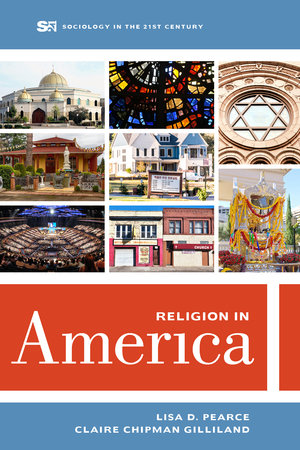By Lisa D. Pearce and Claire Chipman Gilliland, authors of Religion in America
Everybody has an opinion about the state of religion in America. Not everybody has a comprehensively informed opinion about it.
Many of our students take sociology of religion courses specifically to understand how and why religion operates like it does. Some of them are religious, some are critical of religion, and some are agnostic—but they are all genuinely curious. We wrote Religion in America for the curious learners in our courses and beyond.
Casual observers of highly charged public debates might assume all religion is dying or being co-opted by political operatives. Additionally, students might conclude from many textbook treatments of religious trends in the U.S. that changes in average levels of religiousness reflect widespread, conscious changes in religious belief when this is not always the case. We encourage readers to push beyond simplistic notions to better understand and evaluate religious change and stability in the U.S.
Our book, Religion in America, provides three unique but compatible perspectives for understanding the religious contours of the United States. First, we present a demographic or population standpoint on religion in America. This involves unpacking national trends for demographic subgroups to show, for example, that declines in religious service attendance over the past few decades are largely driven by White Americans with a high school degree or less. Looking at other demographic subgroups, especially African Americans, suggests much more continuity than headlines proclaim.
Another feature of a demographic perspective is considering how changes in the composition of a population might alter levels of religiousness even when no one individual changes anything about their beliefs or practices. For example, we find that growing racial and ethnic diversity and the aging of the American population have lifted levels of religiousness over time. In other words, when these groups grow as a proportion of the American population, they shift national levels of religiousness higher. Alternatively, the shrinking of household size through lower fertility, greater female employment, and a higher divorce rate has contributed to a less religious population overtime. So, how the U.S. population changes in seemingly non-religious ways reveals much about what to expect in terms of national trends in religiousness.
The second lens we provide for thinking about religion in America is a congregational one. Religious trends are usually based on individual-level, self-reported survey data. But religious institutions are an essential part of the religious landscape in America. In fact, religiously active Americans are increasingly concentrating themselves in very large congregations, such as megachurches. The turnover rate and difficulty for attendees to create close ties within these large institutions may ultimately loosen Americans’ ties to religious institutions.
Our third perspective on the state of religion in America is a historical one. We trace forms of religious and political alliance all the way back to the beginning of America, concluding that you cannot understand trends in religious affiliation, practice, or belief without understanding how religion has been harnessed to protect power. White Protestants using religious rhetoric and beliefs to justify and protect their social standing is evident in their crusades against Catholic teachers in public schools, alcohol sales by immigrant-owned businesses, or the racial integration of schools. The current conflation of White evangelicalism and nationalistic Republicanism is a recent case of a long running pattern.
The demographic, congregational, and historical perspectives we provide combine to form a comprehensive understanding of the state of religion in America. However, chapters can also stand alone as supplements to other materials in a range of courses. For example, class meetings or units on religion and race might involve reading Chapter 1: Racial and Ethnic Variation in Religion and Its Trends. As we note in a callout box on page 35, the chapter pairs nicely with a college teaching module on “Race/Ethnicity and Religion in American History” provided by The Association for Religion Data Archives, giving students the opportunity to read about trends and then to conduct their own investigation of social science data. Population or demography classes might use Chapters 1-3 of our book as a specific application of concepts like age, period, and cohort effects. Chapter 4, on congregational-level change would pair nicely with an ethnography of a congregation such as Korie Little Edwards’ book, The Elusive Dream: The Power of Race in Interracial Churches, or her co-hosted podcast by the same name.
In the U.S., religion is changing and complicated, yet vibrant. Our population will continue to change demographically, in ways that shift religious averages. Some religious institutions will innovate, and religious ideologies will continue to be cause and consequence of social change. Our book shines a light on these various dynamics to thoroughly inform the widespread curiosity about religion in America that we regularly encounter.


